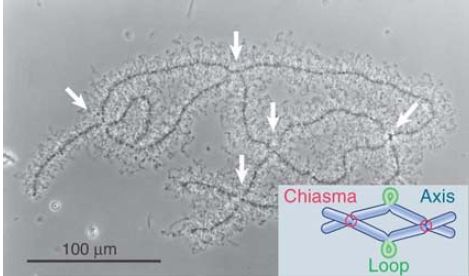


 النبات
النبات
 الحيوان
الحيوان
 الأحياء المجهرية
الأحياء المجهرية
 علم الأمراض
علم الأمراض
 التقانة الإحيائية
التقانة الإحيائية
 التقنية الحيوية المكروبية
التقنية الحيوية المكروبية
 التقنية الحياتية النانوية
التقنية الحياتية النانوية
 علم الأجنة
علم الأجنة
 الأحياء الجزيئي
الأحياء الجزيئي
 علم وظائف الأعضاء
علم وظائف الأعضاء
 الغدد
الغدد
 المضادات الحيوية
المضادات الحيوية|
Read More
Date: 5-6-2021
Date: 7-11-2020
Date: 3-1-2016
|
Lampbrush Chromosomes Are Extended
KEY CONCEPT
Sites of gene expression on lampbrush chromosomes show loops that are extended from the chromosomal axis.
It would be extremely useful to observe gene expression in its natural state in order to see what structural changes are associated with transcription. The compression of DNA in chromatin, coupled with the difficulty of identifying particular genes within intact chromatin, makes it impossible to visualize the transcription of individual active genes, although advances in live imaging and microscopic resolution are beginning to overcome that limitation.
Scientists can observe gene expression directly in certain unusual situations in which the chromosomes are found in a highly extended form that allows individual loci (or groups of loci) to be distinguished. Lateral differentiation of structure is evident in many chromosomes when they first appear for meiosis. At this stage, the chromosomes resemble a series of beads on a string. The beads are densely staining granules, properly known as chromomeres.
Chromomeres are larger and distinct from individual nucleosomes, which are also sometimes referred to as beads on a string . In general, though, there is little gene expression at meiosis, and it is not practical to use this material to identify the activities of individual genes. An exceptional situation that allows the material to be examined is presented by lampbrush chromosomes, which have been best characterized in certain amphibians and birds.
Lampbrush chromosomes are formed during an unusually extended meiosis, which can last up to several months. During this period, the chromosomes exist in a stretched-out form that we can visualize by using a light microscope. At a later point during meiosis, the chromosomes revert to their usual compact size. The extended state provides a unique opportunity to see the structure of the chromosome.
The lampbrush chromosomes are meiotic bivalents, each consisting of paired homologous chromosomes that have been replicated. The sister chromatids remain connected along their lengths and each homolog appears, therefore, as a single fiber. FIGURE 1 shows an example in which the homologs have desynapsed and are held together only by chiasmata that indicate points of chromosome crossover. Each sister chromatid pair forms a series of ellipsoidal chromomeres, 1 to 2 μm in diameter, which are connected by a very fine thread. This thread contains the two sister duplexes of DNA and runs continuously along the chromosome, through the chromomeres.

FIGURE 1 A lampbrush chromosome is a meiotic bivalent in which the two pairs of sister chromatids are held together at chiasmata (indicated by arrows).
Photo courtesy of Joseph G. Gall, Carnegie Institution.
The lengths of the individual lampbrush chromosomes in the newt Notophthalmus viridescens range from 400 to 800 μm, compared with the range of 15 to 20 μm seen later in meiosis. Thus, the lampbrush chromosomes are about 30 times less compacted along their axes than their somatic counterparts. The total length of the entire lampbrush chromosome set is 5 to 6 μm and is organized into about 5,000 chromomeres.
The lampbrush chromosomes take their name from the lateral loops that extrude from the chromomeres at certain positions. The arrangement of fibers around the chromosome axis resembles the cleaning fibers of a lampbrush (a common tool back when lampbrush chromosomes were first observed in 1882). The loops extend in pairs, one from each sister chromatid. The loops are continuous with the axial thread, representing chromosomal material extruded from its more compact organization in the chromomere. The loops are surrounded by a matrix of ribonucleoproteins that contain nascent RNA chains. Often, a transcription unit can be defined by the increase in the length of the RNP moving around the loop. The loop is an extruded segment of DNA that is being actively transcribed. In some cases, researchers have identified loops corresponding to particular genes. For these cases, the structure of the transcribed gene—and the nature of the product—can allow for a rare situation wherein gene expression can be directly visualized and studied in situ.



|
|
|
|
التوتر والسرطان.. علماء يحذرون من "صلة خطيرة"
|
|
|
|
|
|
|
مرآة السيارة: مدى دقة عكسها للصورة الصحيحة
|
|
|
|
|
|
|
نحو شراكة وطنية متكاملة.. الأمين العام للعتبة الحسينية يبحث مع وكيل وزارة الخارجية آفاق التعاون المؤسسي
|
|
|